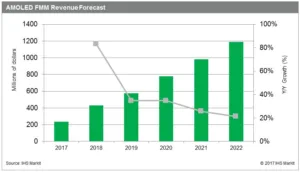The global active-matrix organic light-emitting diode (AMOLED) panel market is forecast to surge 63 percent in 2017 from a year ago to $25.2 billion on growing demand for AMOLED panels in the smartphone and TV industries, according to IHS Markit (Nasdaq: INFO), a world leader in critical information, analytics and solutions.
“Growing use of AMOLED panels in smartphones and rising sales of AMOLED TVs will mainly drive the growth of the AMOLED panel market,” said Ricky Park, director of display research at IHS Markit. “A steady rise in demand from head-mount displays and mobile PCs would also prop up the market.”
The demand for AMOLED displays has rapidly risen in the smartphone market in particular as the flexible substrate allows phones to be produced in various designs with a lighter and slimmer bodies. This year, leading smartphone makers have competitively rolled out premium phones that boast a very narrow bezel or nearly bezel-less designs.
“The AMOLED display market is also expected to get a boost from Apple’s decision to use an AMOLED screen in its iPhone series to be released later this year, and Chinese smartphone makers’ moving to newer applications of AMOLED panels,” Park said. “To meet the burgeoning demand, South Korean and Chinese display makers have been heavily investing in Generation 6 AMOLED fabs.”
According to Display Long-term Demand Forecast Tracker from IHS Markit, the TV industry, the second biggest market for AMOLED panels, will also play a major role in fostering the growth of the AMOLED panel market this year. LG Display, which currently dominates the AMOLED TV panel market, is set to embark on the operation of its second AMOLED TV panel line E4-2 with an aim to mass produce panels in the latter half of this year.
Bumped up by an increase in output, the AMOLED TV panel market is forecast to grow from 890,000 units last year to 1.5 million units this year. By 2021, the AMOLED panel market is projected to expand at a compound annual growth rate of 22 percent to exceed $40 billion.

